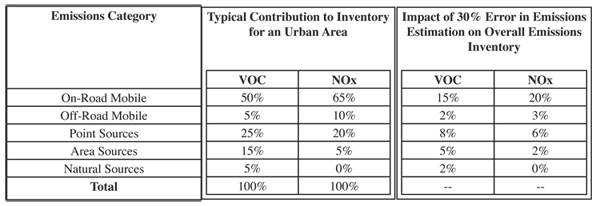Estimating Emissions from Sources of Air Pollution
6.1 Development of an Emissions Inventory
6.1.7 Inventory Accuracy (Quality Assurance)
An emission inventory database is no better than the quality of the data that is placed into the database. Therefore, care must be taken to obtain the most accurate data possible for all sources. It is doubtful that any inventory database presently available can be trusted to be closer than 20% of the actual emissions; although, one might argue that random errors in an inventory could balance out to reduce this error. A quick bounding analysis of emissions data as illustrated in table 6.1.7-1 indicates where the most care must be taken to establish data accuracy to ensure the best overall estimation of the true inventory.
As can be seen from table 6.1.7-1, errors in emissions associated with on-road mobile sources typically impact the overall emissions inventory the most. Point sources will be the second most important consideration followed by Area and Off-Road sources depending upon the pollutant. The contribution to the inventory by different source categories for different pollutants will, of course, vary from location to location and by the hour of the day. Table 6.1.7-1 is provided only to illustrate the point that with limited resources, the greatest care normally must be taken to establish the emissions from On-Road Mobile and Point sources to ensure the most accurate possible emissions inventory. It is worth noting, however, that in California where regulations have been focused on On-Road Mobile and Point sources over the past thirty years that the relative contributions to emissions of Off-Road Mobile and Area sources have become much larger than the levels shown in 6.1.7-1 calling for great care in preparing these inventories as well. Values in 6.1.7-1 are selected to approximate urban areas in developing countries, but should be considered only as an example and not relied upon for any specific analysis.
A program to ensure accuracy of an emission inventory is often referred to as the quality assurance program for inventory development. All emission inventory development programs should involve a quality assurance element. A person(s) involved in the emissions inventory development process should be assigned to analyze data collected in the process to ensure that it makes sense in light of other regional data. For example, the CO2 emission estimates for the combined Mobile source inventories can be compared to the total fuel used in the region of analysis to see that the results are reasonable. If the CO2 estimates for these sources are reasonable then it is more likely that the other Mobile source pollutants are reasonable. Similarly, overall natural gas, coal, and wood use estimates can be used relative to stationary sources. Finally, it is common to use different source receptor analyses processes as discussed in Chapter 5 along with monitored amounts of pollutants discussed in Chapter 4 to compare with the derived inventory estimates. It is noteworthy that the U.S. EPA emissions database, described in the tables in the previous section requires information be included on the reliability of the emissions estimates for different emission sources.
As can be seen from table 6.1.7-1, errors in emissions associated with on-road mobile sources typically impact the overall emissions inventory the most. Point sources will be the second most important consideration followed by Area and Off-Road sources depending upon the pollutant. The contribution to the inventory by different source categories for different pollutants will, of course, vary from location to location and by the hour of the day. Table 6.1.7-1 is provided only to illustrate the point that with limited resources, the greatest care normally must be taken to establish the emissions from On-Road Mobile and Point sources to ensure the most accurate possible emissions inventory. It is worth noting, however, that in California where regulations have been focused on On-Road Mobile and Point sources over the past thirty years that the relative contributions to emissions of Off-Road Mobile and Area sources have become much larger than the levels shown in 6.1.7-1 calling for great care in preparing these inventories as well. Values in 6.1.7-1 are selected to approximate urban areas in developing countries, but should be considered only as an example and not relied upon for any specific analysis.
A program to ensure accuracy of an emission inventory is often referred to as the quality assurance program for inventory development. All emission inventory development programs should involve a quality assurance element. A person(s) involved in the emissions inventory development process should be assigned to analyze data collected in the process to ensure that it makes sense in light of other regional data. For example, the CO2 emission estimates for the combined Mobile source inventories can be compared to the total fuel used in the region of analysis to see that the results are reasonable. If the CO2 estimates for these sources are reasonable then it is more likely that the other Mobile source pollutants are reasonable. Similarly, overall natural gas, coal, and wood use estimates can be used relative to stationary sources. Finally, it is common to use different source receptor analyses processes as discussed in Chapter 5 along with monitored amounts of pollutants discussed in Chapter 4 to compare with the derived inventory estimates. It is noteworthy that the U.S. EPA emissions database, described in the tables in the previous section requires information be included on the reliability of the emissions estimates for different emission sources.
